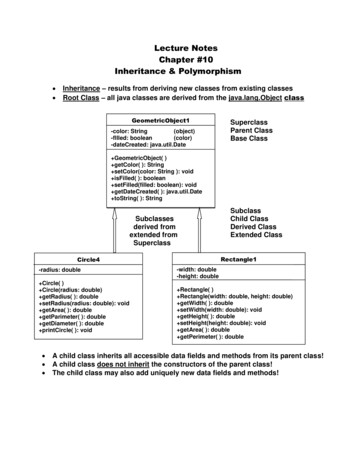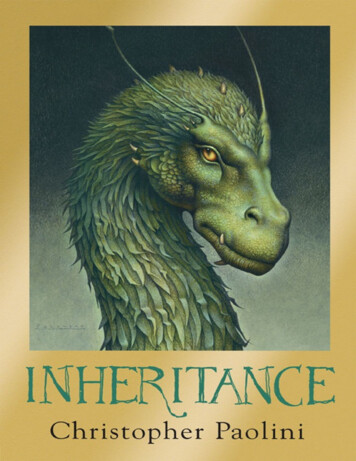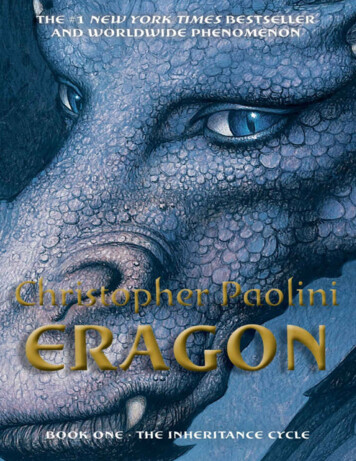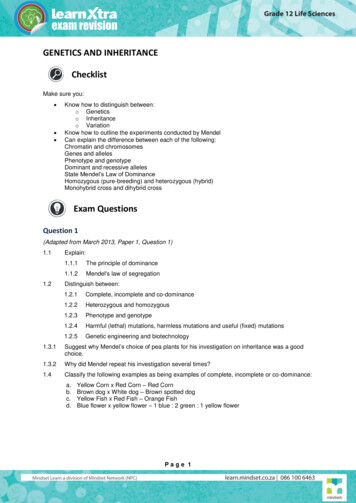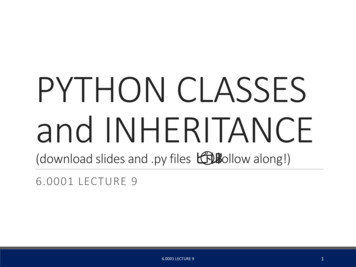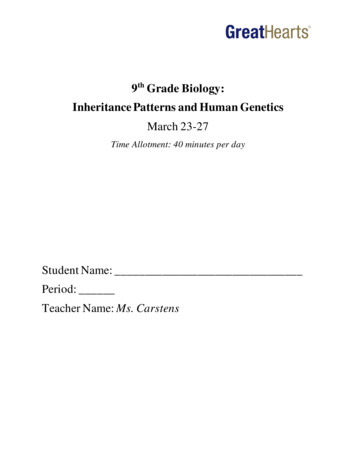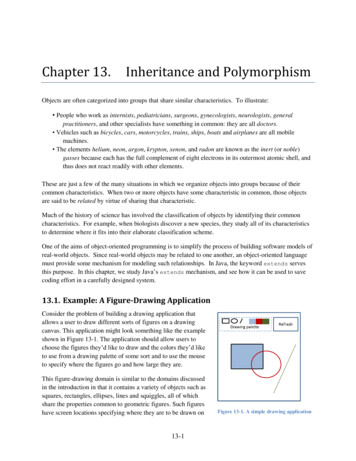
Transcription
Chapter 13.Inheritance and PolymorphismObjects are often categorized into groups that share similar characteristics. To illustrate: People who work as internists, pediatricians, surgeons, gynecologists, neurologists, generalpractitioners, and other specialists have something in common: they are all doctors. Vehicles such as bicycles, cars, motorcycles, trains, ships, boats and airplanes are all mobilemachines. The elements helium, neon, argon, krypton, xenon, and radon are known as the inert (or noble)gasses because each has the full complement of eight electrons in its outermost atomic shell, andthus does not react readily with other elements.These are just a few of the many situations in which we organize objects into groups because of theircommon characteristics. When two or more objects have some characteristic in common, those objectsare said to be related by virtue of sharing that characteristic.Much of the history of science has involved the classification of objects by identifying their commoncharacteristics. For example, when biologists discover a new species, they study all of its characteristicsto determine where it fits into their elaborate classification scheme.One of the aims of object-oriented programming is to simplify the process of building software models ofreal-world objects. Since real-world objects may be related to one another, an object-oriented languagemust provide some mechanism for modeling such relationships. In Java, the keyword extends servesthis purpose. In this chapter, we study Java’s extends mechanism, and see how it can be used to savecoding effort in a carefully designed system.13.1. Example: A Figure-Drawing ApplicationConsider the problem of building a drawing application thatallows a user to draw different sorts of figures on a drawingcanvas. This application might look something like the exampleshown in Figure 13-1. The application should allow users tochoose the figures they’d like to draw and the colors they’d liketo use from a drawing palette of some sort and to use the mouseto specify where the figures go and how large they are.This figure-drawing domain is similar to the domains discussedin the introduction in that it contains a variety of objects such assquares, rectangles, ellipses, lines and squiggles, all of whichshare the properties common to geometric figures. Such figureshave screen locations specifying where they are to be drawn on13-1Figure 13-1. A simple drawing application
the canvas, fill settings specifying whether they are to be filled with color or merely outlined, and colorsettings specifying the colors to use. There are also interesting relationships between the different figuretypes. Squares are also rectangles but not the reverse. Ellipses can be filled, but not lines.A programmer could build different classes to model each figure type, e.g., Rectangle, Ellipse,Line, etc., but that would likely lead to considerable amounts of redundant code. For example, everyfigure class would have to store an instance variable specifying their color and provide largely identicalconstructors, accessors and mutators for initializing and managing that variable’s value. Redundancy suchas this is rarely a good programming practice.This chapter introduces the techniques offered by object-oriented programming for implementingapplications such as this in a more concise and consistent manner.13.2. Modeling Objects and RelationshipsThe object-oriented programming (OOP) paradigm is based on three fundamental mechanisms: EncapsulationInheritancePolymorphismEncapsulation, the focus of Chapter 9, is the language construct that bundles data and methods into asingle class specification. Inheritance and polymorphism are addressed in the following sections. As we’llsee, inheritance is a mechanism for sharing common features amongst classes while polymorphism is amechanism for designating unique features for each class.13.2.1. Revisiting the ExampleBefore discussing inheritance and polymorphism, this section presents a first iteration of the figuredrawing application introduced in Section 13.1, which we will call Simpledraw. It is not difficult toimplement a rectangle-drawing version of Simpledraw using mechanisms covered earlier in the text.13-2
324252627282930313233343536373839/*** A simple rectangle-drawing class** @author kvlinden* @version Fall, 2009*/public class Rectangle {privateprivateprivateprivatePoint myStart;int myColor;int myWidth, myHeight;boolean myFilled;public Rectangle(Point start, int width, int height,int color, boolean filled) {myStart start;myColor color;myWidth width;myHeight height;myFilled filled;}public int getColor() {return myColor;}public void setColor(int color) {myColor color;}public void render(PApplet p) {p.stroke(myColor);if (myFilled) {p.fill(myColor);} else {p.noFill();}p.rect(myStart.x, myStart.y, myWidth, myHeight);}}The class models a rectangle by encapsulating: instance variables representing the rectangle’s starting point (its upper left point), its color,width, height and a boolean indicating whether it is to be filled with color or simply outlinedmethods specifying how to construct and draw the figure, and an accessor and mutator for thecolor attribute.As has been our practice since Chapter 11, the render() method receives the drawing context from itscalling object, which must be a PApplet, and uses Processing-based drawing methods to render therectangle on the canvas.As it stands, this class is a perfectly appropriate model of a rectangle, but when we consider addingsupport for ellipses, lines and other figure types, it’s clear that they too will need to represent a color13-3
attribute and provide support for that attribute in the constructor, draw methods, accessors and mutators.As mentioned in the previous section, we’d like to avoid reproducing this amount of redundant code;redundant code is time-consuming to produce and can lead to inconsistencies, say, in the way color ishandled for each of the figure types. We would prefer to specify the color attribute in one place and allowall the figure objects to share that attribute.13.3. InheritanceInheritance is a language construct that supports the sharing of features amongst different objects.Consider the domain of vehicles, which includes bicycles, skateboards, cars and jets. On the one hand,vehicles of these types share some common features; they tend to be manufactured by particularcompanies and identified by a model name or number. For example, the “7.4FX” is a particular bicyclemodel manufactured by Trek Corporation and the “Rocket” is a particular skateboard modelmanufactured by Ally Corporation. On the other hand, each of these vehicle types tends to havedistinguishing features not shared by other vehicle types. For example, bicycles can be assessed by theirnumber of gears, e.g., 27 for the Trek 7.4FX, while skateboards can be assessed by the length of theirboard, e.g., the Rocket has a 31.5-inch board.Inheritance allows a programmer to separate those attributes and behaviors that are shared betweenvehicle types and those that are unique to each particular type. The shared features are collected in asingle class known as the parent or superclass and the unique features are separated into the child orsubclasses. This can be visualized as follows.In class diagrams such as this, subclasses point up to their superclass. The attributes and behaviorsimplemented in the superclass are “inherited” by all the subclasses. The attributes and behaviorsimplemented in one of the subclasses are unique that subclass. In a sense, the features shared by subclass1and subclass 2, that might otherwise have been implemented separately in each of the subclasses, can becollected and “raised up” into the single shared superclass.Because Java does not implement multiple inheritance, subclasses can only have one superclass.Superclasses, on the other hand, can have many subclasses.For example, in the vehicles domain, a programmer might implement the brand and model in a vehiclesuperclass, the engine size in a car subclass and the number of jet engines in a jet subclass.13-4
13.3.1. The extends ClauseInheritance is implemented in Java using the extends clause. A class Subclass1 can inheritattributes and behaviors from another class Superclass as follows:class Superclass {// attributes and behaviors shared by all subclasses.}class Subclass1 extends Superclass {// attributes and behaviors unique to Subclass1.}The extends Superclass clause specifies the inheritance. It indicates that any object of typeSubclass1 is also an object of type Superclass and thus that a Subclass1 object can do anythingthat a Superclass object can do. This construct provides considerable power for code sharing andreuse.For example, in the vehicle domain we could implement a Vehicle superclass as 02122232425262728293031323334class Vehicle {private String myBrand, myModel;public Vehicle() {myBrand "unknown";myModel "unknown";}public Vehicle(String brand, String model) {setBrand(brand);setModel(model);}public String getBrand() {return myBrand;}public void setBrand(String brand) {myBrand brand;}public String getModel() {return myModel;}public void setModel(String model) {myModel model;}public String toString() {return getBrand() " " getModel();}}13-5
This class models a vehicle object by storing the brand and model attributes for that object and providingconstructors, accessors and mutators for maintaining those attributes. This class is implemented in thesame manner that we implemented classes in Chapter 9. Given this (super)class, we can now implementa Bicycle subclass as 021class Bicycle extends Vehicle {private int myGearCount;public Bicycle() {myGearCount 1;}public Bicycle(int gearCount) {setGearCount(gearCount);}public int getGearCount() {return myGearCount;}public void setGearCount(int gearCount) {myGearCount gearCount;}}This Bicycle class inherits all the features of the Vehicle class and adds additional features handlingthe number of gears of the bicycle. Given these class definitions, we can write the following codesegment.Code:Bicycle trek74 new tput:27Trek 7.4FXThis code segment declares a bicycle object, trek74, sets its number of gears to 27 and prints thatnumber out (thus the first line of the output). This is standard behavior for the classes we’ve worked within previous chapters, implemented using the myGearCount instance variable and its associated accessorand mutator methods. The next segment of code, however, sets the brand and model of the trek74object to “Trek” and “7.4FX” respectively and prints the object itself out using the toString()method. This behavior is not implemented in the Bicycle class itself; it is inherited from the Vehicle13-6
class. Thus, we can say that a Bicycle object is a Vehicle object in that it can do anything that aVehicle object can do.With the features shared by vehicle objects implemented in the Vehicle class, we can now define newvehicle subclasses that share those same features. The following class defines a skateboard class thatreuses the vehicle 8192021class Skateboard extends Vehicle {private double myBoardLength;public Skateboard() {myBoardLength 0;}public Skateboard(double boardLength) {setBoardLength(boardLength);}public double getBoardLength() {return myBoardLength;}public void setBoardLength(double boardLength) {myBoardLength boardLength;}}This Skateboard class inherits the vehicle features just as the Bicycle class does, as can be seen inthe following code segment.Code:Skateboard board new board);Output:31.5Ally RocketAs with the Bicycle class, the Skateboard class inherits the support for the brand, model and thetoString() method, to which it adds unique support for board length.This class structure for our vehicle domain can be viewed as follows.13-7
The Vehicle class’s instance variables, myBrand and myModel, and its toString() method arelisted in the Vehicle class box; the associated accessors and mutators are not explicitly listed to savespace. Similarly, the Bicycle and Skateboard each define their own instance variables:myGearCount and myBoardLength respectively.13.3.2. Multi-Level InheritanceInheritance is a recursive mechanism and can therefore be used to implement multiple levels of sharing.The Java extends clause can be used as shown in the code here on the left to produce the class structureshown on the right.class SuperClass {// features shared by all descendants.}class SubClass extends SuperClass {// features shared by descendants of SubClass.}class SubSubClass extends SubClass {// features unique to SubSubClass.}SuperClassSubClassSubSubClassIn this structure, objects of type SubSubClass inherit features from both SubClass and SuperClass. Thismechanism provides the ability to create tree-shaped class hierarchies that can be used to share featuresamongst subsets of subclasses.In the vehicle domain, this can be useful when we introduce cars and jet airplanes. Cars and jets arevehicles that are mechanically powered, and thus share features related to fuel and fuel consumption.Because bicycles and skateboard are not powered, it makes no sense to introduce these features at thelevel of the Vehicle class, but we can introduce a new level in the class hierarchy for powered vehiclesas shown here.13-8
Vehicle myBrand myModel toString()PoweredVehicle myFuelTypeBicycleSkateboard myGearCount myBoardLengthCarJet myEngineS
13-1 Chapter 13. Inheritance and Polymorphism Objects are often categorized into groups that share similar characteristics. To illustrate: People who work as internists, pediatricians surgeons gynecologists neurologists general practitioners, and other specialists have something in common: they are all doctors. Vehicles such as bicycles, cars, motorcycles, trains, ships, boats and .
